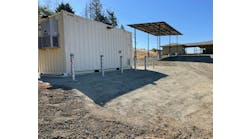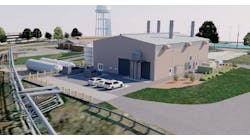A small town named after an Aztec emperor will one day be home to what is touted as the first microgrid in rural Iowa.
The U.S. Department of Energy (DOE) has selected a microgrid project partnering Iowa State University (ISU) and Montezuma Municipal Light & Power for a federal award of about $9.5 million. This DOE award will be coupled with close to $2.4 million from Iowa State and the utility to fund construction of a utility-scale microgrid for the community.
Montezuma is a town of about 1,400 residents some 70 miles east of Des Moines. It was established in the 19th century and was given its name by local veterans of the Mexican-American War in reference to the last Aztec emperor of Mexico.
Once a stagecoach and rail hub, Montezuma has evolved over the years. This new microgrid project will transform the electricity generation and distribution system in the town, ISU researchers and Montezuma Municipal Power & Light officials say. It will replace aging substations and provide Montezuma with its first two electric vehicle chargers, according to an ISU release.
“Our reliability will increase with the new, more modern switchgear, and our outage time will be reduced by having new controls,” Kevin Kudart, superintendent of Montezuma Municipal Power & Light, said in a statement. “And we’ll promote good customer relations by providing vehicle charging stations.”
The solar-powered microgrid will generate 3 MW at capacity. Utility officials and ISU added that it would offset its costs by reducing outside energy purchases by 3.5 GWh annually and transmission costs by 15%.
Overall, the project is expected to drop energy costs in Montezuma by an estimated 18%. The additional $2.4 million for funding the microgrid will be paid mainly in a cost share by the city and university, according to news reports.
“This project will make the entire town of Montezuma the very first utility-scale microgrid in Iowa with the best reliability and resilience,” Zhaoyu Wang, a Northrop Grumman associate professor of electrical and computer engineering at Iowa State and also the project leader, said. “It will be a model for other rural utilities.”
Montezuma’s microgrid was one of 17 such projects included in the DOE award as part of the Energy Improvements in Rural or Remote Areas program. This program is managed by DOE’s Office of Clean Energy Demonstrations.
This is not the first utility-scale microgrid project in the U.S., as utilities have developed island-able, stand-alone systems for years. In 2017, Ameren completed a $5 million microgrid at its Technology Applications Center near the University of Illinois campus in Champaign.
Last year, leaders in Cuyahoga County, Ohio, approved a 10-year contract with Compass Energy Platform to create a self-contained microgrid utility involving three projects to be completed before the end of this decade.
---
For anyone wanting to learn more about such projects at a closer level, the Microgrid Knowledge 2024 Conference, happening April 22-24 in Baltimore, will feature university and utility projects among its content sessions.
Participants in Microgrid 2024 will include industry experts from Ameren, the University of Illinois-Champaign, Compass Energy Platform, Gallaudet University, the University of St. Thomas, Minnesota’s, Center for Microgrid Research, Duke Energy, Exelon and Pacific Gas & Electric, among others.
Early bird registration is available until March 17.








